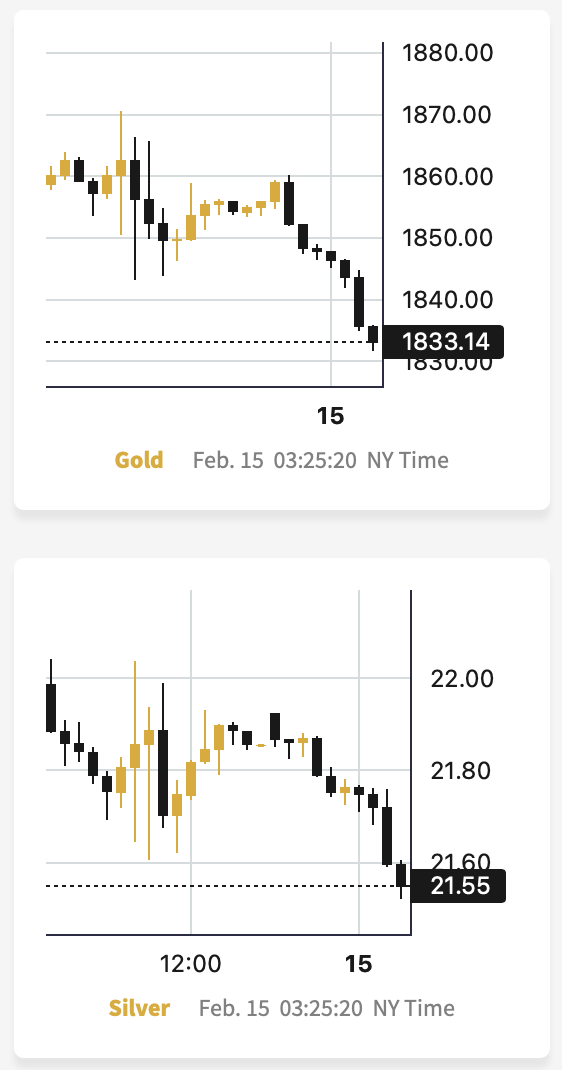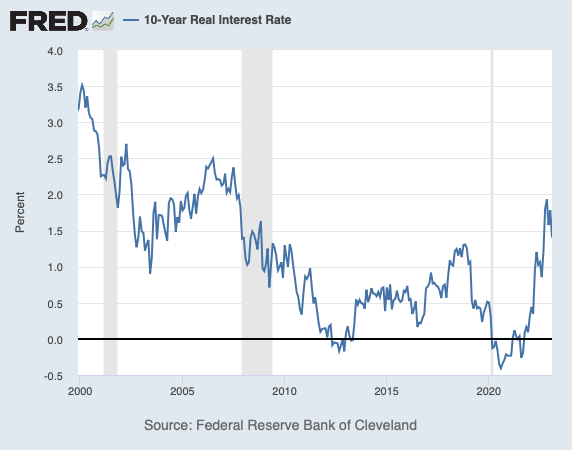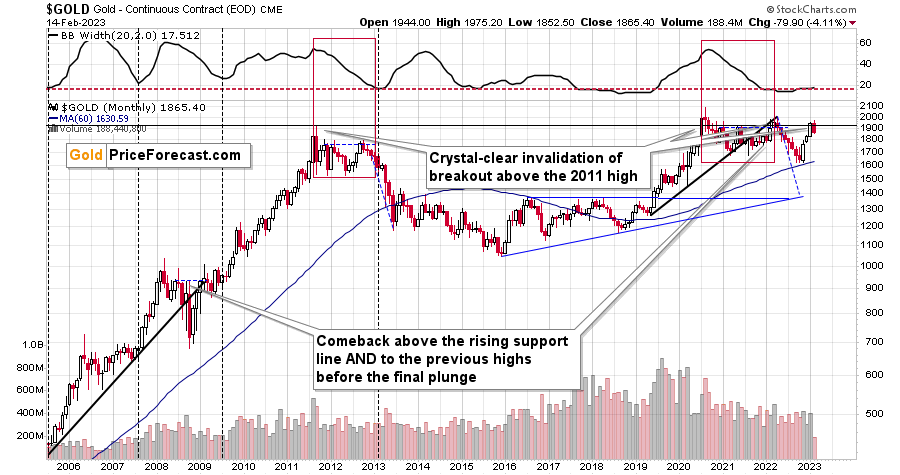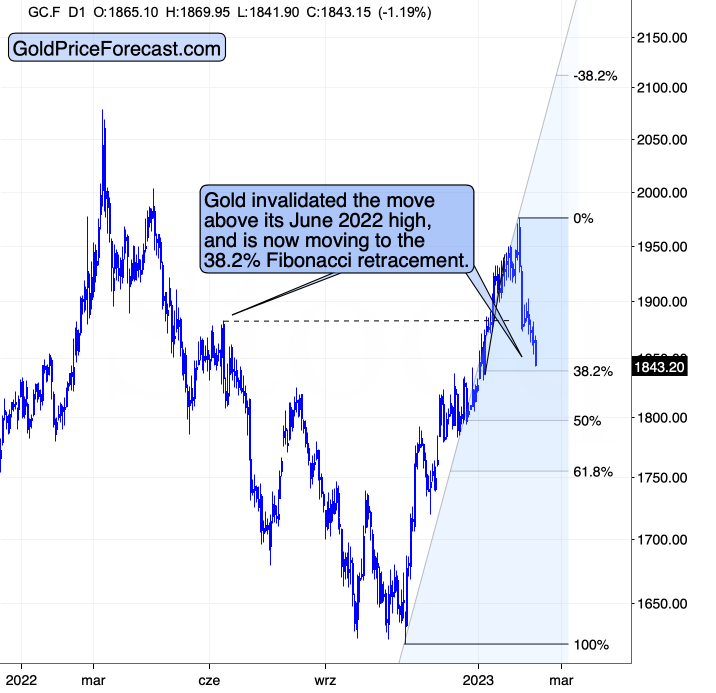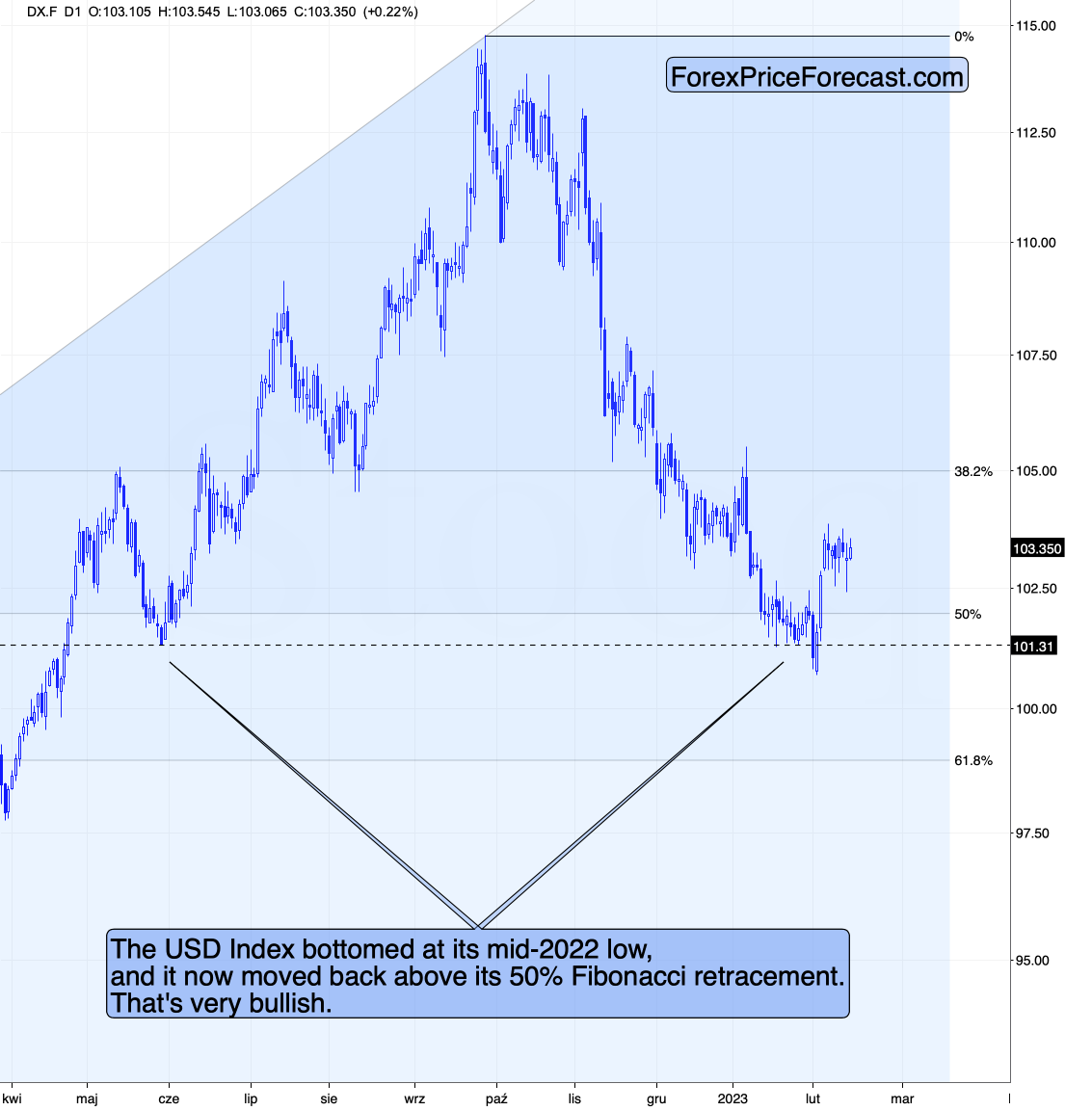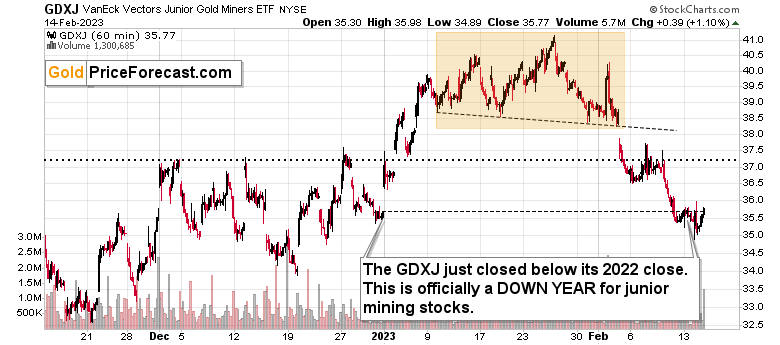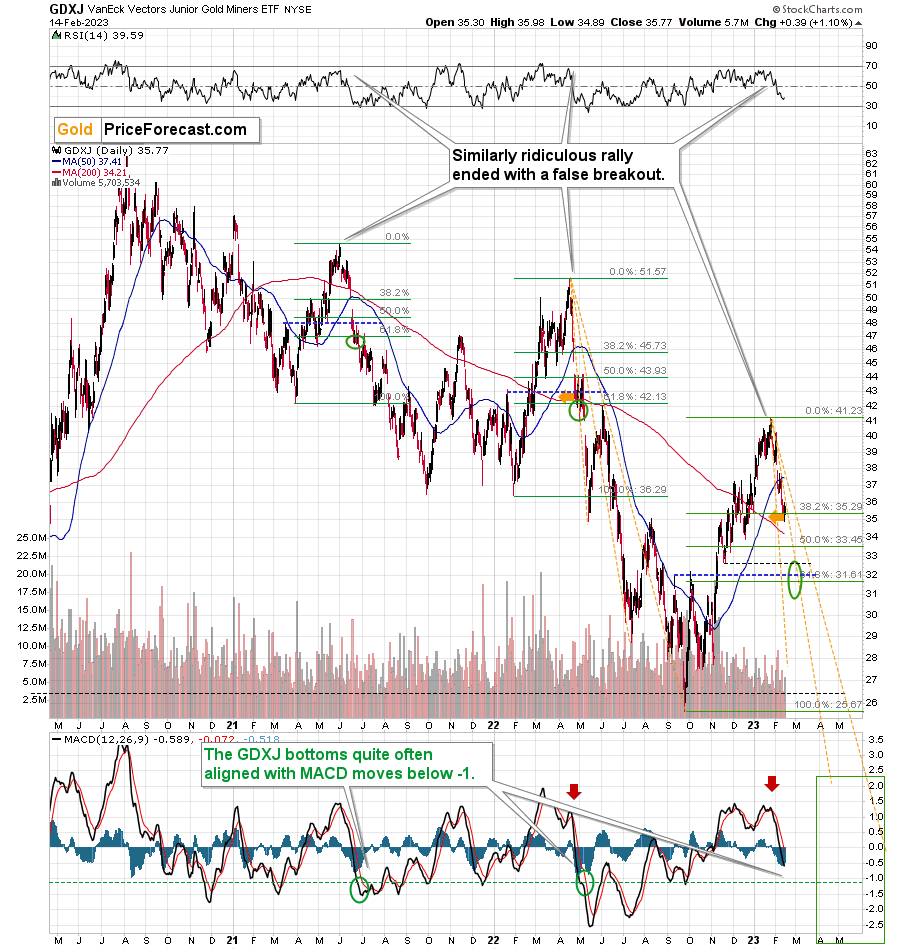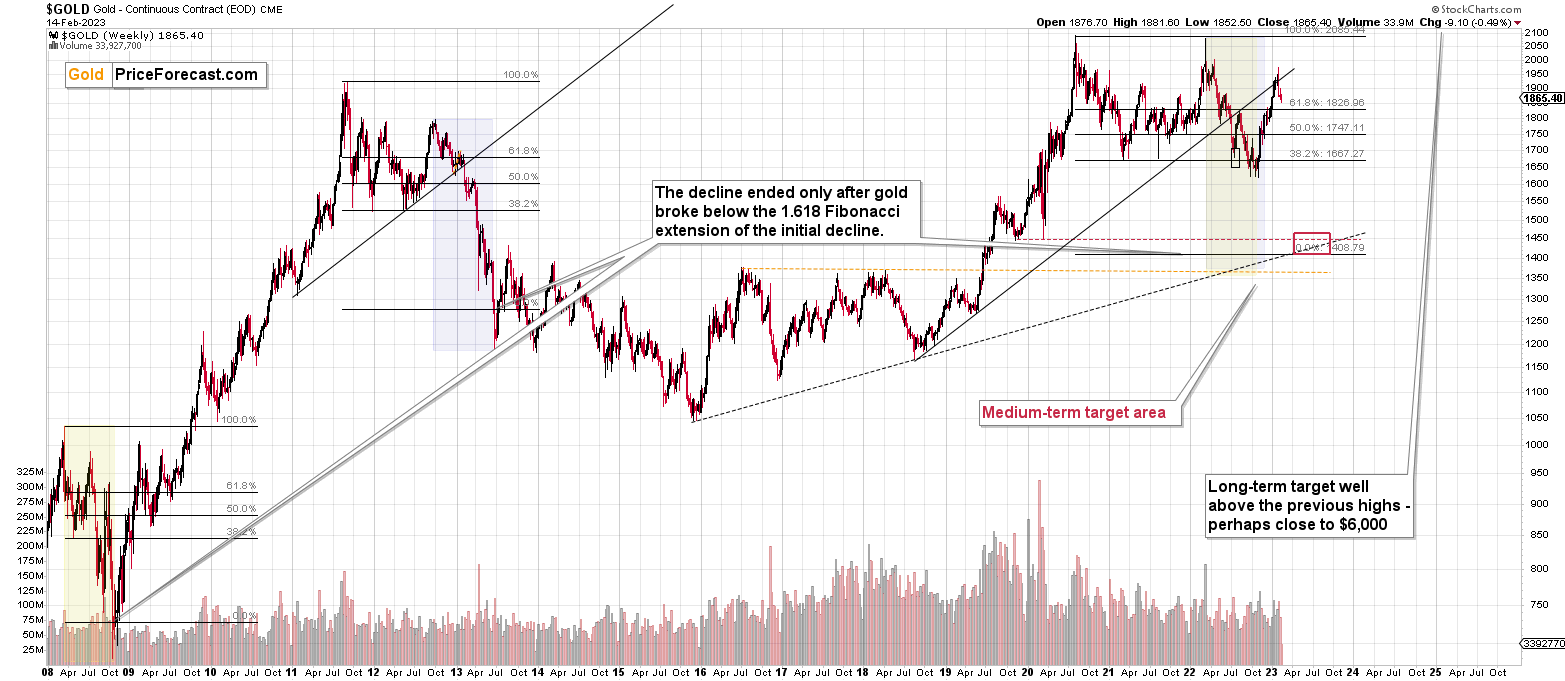Briefly: in our opinion, full (300% of the regular position size) speculative short positions in junior mining stocks are justified from the risk/reward point of view at the moment of publishing this Alert.
Gold stocks and silver are sliding to new 2023 lows, and gold (after closing 2022 at $1,826.20) is catching up. Will it cancel its entire 2023 rally?
In all likelihood – yes. Then it’s likely to slide more – much more. With this pace (chart courtesy of GoldPriceForecast.com), gold could move below $1,800 in no time.
But why would it decline at all? Isn’t the war in Europe a reason for gold to rally? Isn’t inflation declining so the Fed can lower rates and thus cause gold to rally?
No – it’s not that simple.
First, gold already rallied due to the Russian invasion – whatever was likely to happen based on that news, already happened. Interestingly, gold already gave away all those war-tension-based gains and then declined more (in the following months of 2022). So, no, neither this nor other geopolitical events are likely to make gold rally in a sustainable manner. In fact, geopolitical events tend to cause only temporary safe-haven rallies in the gold price – and that’s what we saw last year.
Second, gold’s link with inflation is not that clear. Gold does rally in hyperinflationary scenarios, and it tends to perform well in stagflation. However, in cases of moderate to low inflation, it doesn’t necessarily rally.
In REALity (pun intended), it’s all about real interest rates, not either inflation on its own or nominal interest rates on their own.
Putting fancy economic terms aside, it all comes down to whether one can easily gain extra income by lending out capital at interest or whether this action would make one lose money anyway.
In other words, will the gains (interest) be bigger than the losses due to the declining value of money (inflation)?
If the interest is bigger than inflation, “it’s all good.”
If the inflation is greater than the interest, then people can expect to lose money (its value) even if they are lending it out to someone else. That’s what they want to be protected against, for example, by buying gold, which is known to have served as money for thousands of years.
The difference between nominal interest rates and the (expected) inflation rate is the real interest rate. The higher it is and the higher it moves, the less and less appealing gold ownership becomes.
In contrast, as real interest rates fall, gold ownership becomes increasingly appealing.
Does it really work?
You bet!
The 10-year real interest rate had been declining for years, just as gold was soaring. And as the rate bottomed in mid-2012, gold plunged.
Please note that this isn’t a precise technical tool that would allow for making short-term forecasts. The rate bottomed in mid-2012, and that wasn’t the final top in gold. The final top in gold formed one year before, but what formed in mid-2012 was the final “good-bye top” before the huge decline started.
When did we see another real-rate bottom, and even an attempt to move well below the previous low? In mid-2020. This time, the link was quite precise, as that’s exactly when gold topped, too.
Now, the real rates are up after a sizable rally, and they are at their highest levels in over a decade. Gold didn’t decline to its decade-plus low. Is something wrong with the above line of thought?
Not necessarily. Please note that back in 2011 and 2012, gold had approximately a year-long (!) delay in reacting to the fact that there was a bottom.
Back in 2012, gold still moved higher, but it wasn’t able to show the same kind of strength as before the 2011 top. This is exactly what we saw recently, during the short-term corrective upswing.
Gold’s delay is significant, but reality will catch up sooner or later. Probably very soon, because the delay is already huge.
The most extreme aspect of the preceding is that real rates are unlikely to have peaked. Far from it.
I don’t want to go into details today, but in essence, in order to effectively combat inflation, the nominal rates would need to overshoot the CPI year-over-year change. The difference between them is about 2% right now.
Let’s recall what real rates are – the difference between nominal rates and (expected) inflation. The CPI will serve as a proxy for expected inflation here (it’s not perfect, I know, but it’s good enough). As a result, if the Fed is serious about combating inflation (and it is, because inflation has become political! ), real interest rates are likely to rise by at least 2% from their current levels.
And it doesn’t really matter if it happens through higher nominal interest rates or through a lower CPI. Both will probably take place.
Consequently, gold is likely to decline profoundly based on its reaction to what has already happened in real interest rates but also to slide because of the upcoming increase in real interest rates.
Yes, the situation really is extremely bearish (and profitable for those who position themselves correctly – all big shifts create big opportunities), and yes, most people choose to ignore it (and most people will not make profits as the situation unfolds). Why? Because markets (=people) are emotional rather than logical in the short and medium term. That’s one of the reasons why we have those disparities between what should be taking place on the markets and what is really happening. But as time passes, reality is likely to kick in.
Based on today’s slide, it seems that the “kick” is already working.
Gold moved close to its 38.2% Fibonacci retracement level, and it might trigger a small upswing, but we might need to see a bigger decline first. I’d say that the $1,800 level that corresponds to the 50% retracement (approximately) seems to be a more likely candidate for a rebound than the 38.2% retracement, as it’s additionally strengthened by the previous short-term lows (approximately) and the fact that it’s a round number.
The USD Index is in a flag formation right now, consolidating and likely gathering strength for another big leap forward. Since gold is already so close to the 38.2% Fibonacci retracement, a sizable rally in the USDX is likely to make gold decline in a sizable manner too. This likely means a move below the 38.2% Fibonacci retracement, and the next strong short-term support is provided by the $1,800 level.
Actually, I'm not ruling out the possibility of gold falling even further—to its 61.8% retracement (just above $1,750) before rebounding, but the $1,800 level remains the most likely short-term (and only!) downside target.
And as gold and silver declined in today’s pre-market trading, gold miners are likely to decline during today’s session as well.
The GDXJ ETF closed the day slightly above its 2022 close. However, it closed very close to it, and it also closed very close to the lower border of the early-January price gap.
This resistance held, and it still seems like the last few days’ performance was a consolidation before another slide lower – just like what we saw between Feb. 6 and Feb. 9.
Consequently, my previous comments on GDXJ’s downside targets remain up-to-date:
Speaking of junior miners, I went through the short-term chart once again, and I revisited my near-term downside target for the GDXJ.
Based on how fast the previous declines happened, and given how far the mining stocks are likely to decline, let’s keep in mind that the real risk during this downswing is to be out of the trade or – in particular – to be positioned against it (by being long) – at least, that’s the case in my opinion based on about two decades of experience in this sector.
And yes, it remains VERY LIKELY that junior miners will decline very far.
First of all, just look at the orange lines, which feature the repeat of what happened in 2022.
Second, please consider the long-term analysis of the HUI Index in Friday’s analysis.
Third, please note that real rates are going higher based on very precise historical analogies.
Fourth, please keep in mind how much worse the situation is in the eurozone (sovereign debt, e.g., in Italy…) and in Japan than in the U.S. – that’s what drives the currency exchange rates, not just the situation in the U.S. on its own – it all works on a comparative basis.
Fifth, please consider what I already wrote earlier today about junior miners’ weak performance since the 2011 top and about gold’s performance relative to its 2011 top.
So, it’s not a matter of aiming to detect all possible tiny corrective upswings, but only the bigger ones. Given the analogy to the previous corrective upswings, it seems that the GDXJ first needs to move to or a bit below its 61.8% Fibonacci retracement based on the entire recent rally.
I marked the previous cases with green Fibonacci retracements, and you can see that the above happened in both cases. Interestingly, the GDXJ also bottomed close to the recent price extreme: high or low. I marked that with blue dashed lines.
This means that the GDXJ ETF would be likely to move to about $32 before launching a corrective upswing. We would also be likely to get a confirmation from the MACD indicator, which moved below -1 before the GDXJ formed short-term bottoms. This was also a good signal in the case of the previous similar declines (which I marked with green ellipses).
When could this short-term bottom take place? As early as this month, but probably not yet this week.
That is most likely at the time of writing these words, and I will, of course, keep you updated on any changes. Whether one wants to trade the possible corrective upswing or not is a different matter, but it does indeed seem likely that we might see some correction from those levels. Please note that the decision to take advantage of the corrective upswing vs. the decision to wait it out while focusing on the big, medium-term downswing is highly individual. As is the case with pretty much everything, it’s best to keep oneself in mind: one’s risk tolerance, goals and motivations for them, time that one can dedicate to monitoring the situation, and so on.
Overview of the Upcoming Part of the Decline
- It seems to me that the corrective upswing is over (or about to be over) and that the next big move lower is already underway (or that it’s about to start).
- If we see a situation where miners slide in a meaningful and volatile way while silver doesn’t (it just declines moderately), I plan to – once again – switch from short positions in miners to short positions in silver. At this time, it’s too early to say at what price levels this could take place and if we get this kind of opportunity at all – perhaps with gold prices close to $1,500 - $1,550.
- I plan to switch from the short positions in junior mining stocks or silver (whichever I’ll have at that moment) to long positions in junior mining stocks when gold / mining stocks move to their 2020 lows (approximately). While I’m probably not going to write about it at this stage yet, this is when some investors might consider getting back in with their long-term investing capital (or perhaps 1/3 or 1/2 thereof).
- I plan to return to short positions in junior mining stocks after a rebound – and the rebound could take gold from about $1,450 to about $1,550, and it could take the GDXJ from about $20 to about $24. In other words, I’m currently planning to go long when GDXJ is close to $20 (which might take place when gold is close to $1,450), and I’m planning to exit this long position and re-enter the short position once we see a corrective rally to $24 in the GDXJ (which might take place when gold is close to $1,550).
- I plan to exit all remaining short positions once gold shows substantial strength relative to the USD Index while the latter is still rallying. This may be the case with gold prices close to $1,400 and GDXJ close to $15 . This moment (when gold performs very strongly against the rallying USD and miners are strong relative to gold after its substantial decline) is likely to be the best entry point for long-term investments, in my view. This can also happen with gold close to $1,400, but at the moment it’s too early to say with certainty.
- The above is based on the information available today, and it might change in the following days/weeks.
You will find my general overview of the outlook for gold on the chart below:
Please note that the above timing details are relatively broad and “for general overview only” – so that you know more or less what I think and how volatile I think the moves are likely to be – on an approximate basis. These time targets are not binding nor clear enough for me to think that they should be used for purchasing options, warrants, or similar instruments.
Letters to the Editor
I received a few messages in our e-mail inbox, but I will copy-paste them to the comments feed below my premium articles (as a reminder, the “Gold Trading Alert” space on Golden Meadow is reserved to subscribers – it’s not accessible publicly) along with my replies.
Please post your questions in the comments feed below the articles, if they are about issues raised within the article (or in the recent issues), and if they are about other, more universal matters, I encourage you to use the Ask the Community space (I’m also part of the community, after all), so that more people can contribute to the reply and then enjoy the answer. Of course, let’s keep the target-related discussions in the Gold Trading Alerts space.
Summary
To summarize, in my view, the real interest rates are up and about to soar higher, the USD Index most likely bottomed and is likely to soar, while the precious metals topped in a spectacular manner and are now likely to slide – either shortly or soon enough. The rally in gold, silver, and miners was indeed sizable, but… it’s over.
What’s next? Something exciting (and, in my view, very lucrative) or something scary – depending on how positioned and informed one chooses to be.
Also, please note that (paraphrasing Sun Tzu) “understanding the enemy without understanding your true self is only half of a victory.” Before applying any insights into actionable practice (and placing or adding to your trades), please make sure that the position that you’re about to enter and its size are aligned with your approach, your investment goals, and your risk tolerance.
In other words, I suggest starting with yourself, and tailoring the trade to you, not the other way around. Please consider your motivation for this trade and how it aligns with the rest of your approach and life in general.
Hint: don’t go for the easy answer like “money” or “profits,” but consider why the result of the trade is important – is this a part of your well-designed strategy and “you have it,” or is it something you “must absolutely do” – in other words, “it has you”…)
This will save you lots of stress, which is not only end in and of itself (your happiness and health are both closely linked to your stress levels), but it also helps you become a more profitable investor as less stress (or none thereof) means more objectivity and less risk of “running for the hills” right before a given trade becomes profitable (perhaps extremely so).
Given the above, gold’s invalidation of the temporary move above its very long-term resistance (the 2011 high!), and the situation in the USD Index, it seems that the next big move lower in the precious metals sector is already underway.
Now, as more investors realize that interest rates will have to rise sooner than expected, the prices of precious metals and mining stocks (as well as other stocks) are likely to fall. In my opinion, the current trading position is going to become profitable in the following weeks, and quite possibly in the following days. While I can’t promise any kind of performance, I fully expect it to become very profitable before it’s over and to prolong our 2022 winning streak.
After the final sell-off (that takes gold to about $1,350-$1,500), I expect the precious metals to rally significantly. The final part of the decline might take as little as 1-5 weeks, so it's important to stay alert to any changes.
As always, we'll keep you – our subscribers – informed.
To summarize:
Trading capital (supplementary part of the portfolio; our opinion): Full speculative short positions (300% of the full position) in junior mining stocks are justified from the risk to reward point of view with the following binding exit profit-take price levels:
Mining stocks (price levels for the GDXJ ETF): binding profit-take exit price: $20.32; stop-loss: none (the volatility is too big to justify a stop-loss order in case of this particular trade)
Alternatively, if one seeks leverage, we’re providing the binding profit-take levels for the JDST (2x leveraged). The binding profit-take level for the JDST: $22.87; stop-loss for the JDST: none (the volatility is too big to justify a SL order in case of this particular trade).
For-your-information targets (our opinion; we continue to think that mining stocks are the preferred way of taking advantage of the upcoming price move, but if for whatever reason one wants / has to use silver or gold for this trade, we are providing the details anyway.):
Silver futures downside profit-take exit price: $14.32
SLV profit-take exit price: $13.42
ZSL profit-take exit price: $48.87
Gold futures downside profit-take exit price: $1,504
HGD.TO – alternative (Canadian) 2x inverse leveraged gold stocks ETF – the upside profit-take exit price: $16.47
HZD.TO – alternative (Canadian) 2x inverse leveraged silver ETF – the upside profit-take exit price: $36.87
Long-term capital (core part of the portfolio; our opinion): No positions (in other words: cash)
Insurance capital (core part of the portfolio; our opinion): Full position
Whether you’ve already subscribed or not, we encourage you to find out how to make the most of our alerts and read our replies to the most common alert-and-gold-trading-related-questions.
Please note that we describe the situation for the day that the alert is posted in the trading section. In other words, if we are writing about a speculative position, it means that it is up-to-date on the day it was posted. We are also featuring the initial target prices to decide whether keeping a position on a given day is in tune with your approach (some moves are too small for medium-term traders, and some might appear too big for day-traders).
Additionally, you might want to read why our stop-loss orders are usually relatively far from the current price.
Please note that a full position doesn't mean using all of the capital for a given trade. You will find details on our thoughts on gold portfolio structuring in the Key Insights section on our website.
As a reminder - "initial target price" means exactly that - an "initial" one. It's not a price level at which we suggest closing positions. If this becomes the case (as it did in the previous trade), we will refer to these levels as levels of exit orders (exactly as we've done previously). Stop-loss levels, however, are naturally not "initial", but something that, in our opinion, might be entered as an order.
Since it is impossible to synchronize target prices and stop-loss levels for all the ETFs and ETNs with the main markets that we provide these levels for (gold, silver and mining stocks - the GDX ETF), the stop-loss levels and target prices for other ETNs and ETF (among other: UGL, GLL, AGQ, ZSL, NUGT, DUST, JNUG, JDST) are provided as supplementary, and not as "final". This means that if a stop-loss or a target level is reached for any of the "additional instruments" (GLL for instance), but not for the "main instrument" (gold in this case), we will view positions in both gold and GLL as still open and the stop-loss for GLL would have to be moved lower. On the other hand, if gold moves to a stop-loss level but GLL doesn't, then we will view both positions (in gold and GLL) as closed. In other words, since it's not possible to be 100% certain that each related instrument moves to a given level when the underlying instrument does, we can't provide levels that would be binding. The levels that we do provide are our best estimate of the levels that will correspond to the levels in the underlying assets, but it will be the underlying assets that one will need to focus on regarding the signs pointing to closing a given position or keeping it open. We might adjust the levels in the "additional instruments" without adjusting the levels in the "main instruments", which will simply mean that we have improved our estimation of these levels, not that we changed our outlook on the markets. We are already working on a tool that would update these levels daily for the most popular ETFs, ETNs and individual mining stocks.
Our preferred ways to invest in and to trade gold along with the reasoning can be found in the how to buy gold section. Furthermore, our preferred ETFs and ETNs can be found in our Gold & Silver ETF Ranking.
As a reminder, Gold & Silver Trading Alerts are posted before or on each trading day (we usually post them before the opening bell, but we don't promise doing that each day). If there's anything urgent, we will send you an additional small alert before posting the main one.
Thank you.
Przemyslaw K. Radomski, CFA
Founder, Editor-in-chief


